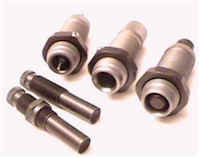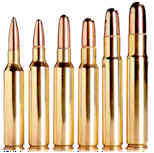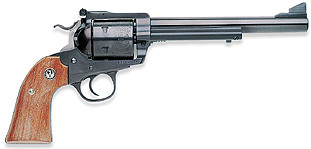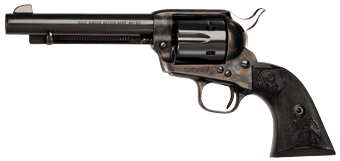 We signed up as a Barnes and Noble Affiliate. Certainly not a big deal, but I have been purchasing a lot of books lately, and I quickly began to understand how aggravating that process can be. Some books look great on-line, then arrive with the appearance of a third grade primer with a BMW price tag.
We signed up as a Barnes and Noble Affiliate. Certainly not a big deal, but I have been purchasing a lot of books lately, and I quickly began to understand how aggravating that process can be. Some books look great on-line, then arrive with the appearance of a third grade primer with a BMW price tag.
Unfortunately, there are also some on-line book stores that list every gun title as out of print or requiring special handling, even when the books are available immediately through other sources. I will exercise care in placing titles on our site store page, avoiding the out of stock titles, over priced titles, and maybe do a quick review of some of the books I have recently received.
I will also keep my eyes open for other sites where books listed out of stock by Amazon and B&N are readily available. If anyone has a publishers site they want to see listed, relating to firearms and shooting sports only, please let me know. The goal is to provide more worthwhile firearms information, not to run a book store.
Two more days
Seems like I’ve been around firearms most of my life, but there still is nothing quite like the anticipated arrival of a new gun. Fortunately my wife is an enthusiast also, so she’s pretty tolerant of my constant references to the subject. UPS has been delivering the supporting material, so I’ve been kept busy with other areas of the project.
 The RCBS carbide three die set came with two extra bullet seating plugs covering hollow point, SWC and round nose.
The RCBS carbide three die set came with two extra bullet seating plugs covering hollow point, SWC and round nose.
Carbide dies means no case lube, and the standard 7/8″-14 size allows me to use them in both the single station Rock Chucker and the progressive Ammo Master press. I’m sure I’ll start off with the single stage press.
 Of course, the .45 Colt shares #20 case holder sets with only the .454 Casull. Three are needed when I start handloading a cartridge; the 5 station shell plate for the Ammo Master, a single shell holder for the Rock Chucker and APS press, and a trim holder for the trimmer.
Of course, the .45 Colt shares #20 case holder sets with only the .454 Casull. Three are needed when I start handloading a cartridge; the 5 station shell plate for the Ammo Master, a single shell holder for the Rock Chucker and APS press, and a trim holder for the trimmer.
It’s silly to have a set for one cartridge, so I may be forced to pick up a .454 from Freedom Arms to get better utilization of this $35 investment. Throw in another $30 for the die set and we are at $65 to set up for a new revolver round.
 Left to right, .44 mag, .45 auto. .45 Colt, .452″ 300 grain and 250 grain Hornady bullets. The .45 Colt is a big case with a greater physical capacity than the .44 mag.
Left to right, .44 mag, .45 auto. .45 Colt, .452″ 300 grain and 250 grain Hornady bullets. The .45 Colt is a big case with a greater physical capacity than the .44 mag.
Since I didn’t have an accumulation of empties to reload, I picked up some bulk Remington brass at 13 cents each. I’ve been using Remington components a lot these days and they seem to really hold up.
I purchased all of this material, same price as everyone else, atLock Stock & Barrel, Valentine Nebraska. They stock what they catalog, have knowledgeable people at the counter, offer fair prices and have both phone and 7×24 on-line ordering.
A little background on the gun and cartridge
The .45 Long Colt was first offered in 1873 as a black powder round for the Colt Peace Maker single action revolver. The Colt Bisley, a target model named after the location of the national shooting matches in Great Britain, went into production in 1893. The Ruger Bisley went into production in 1986 and is currently available in .22 LR, .357 and .44 magnum, and .45 Colt. It is this cartridge’s history of endurance from black powder, to modern firearms and smokeless powder, that makes it interesting.
The .45 Colt seems to parallel the transition of British rounds like the .375 H&H, .416 Rigby and .404 Jeffery. They were all originally designed for black powder, or cordite, or other early forms of smokeless powder. The combination of large case capacity and large bore, permitted more than respectable stopping power, while maintaining relatively low chamber pressures. The low chamber pressure was the margin of safety and reliability for firearms intended for commercial hunting and self defense.
As more improved smokeless powders were developed, and firearms grew increasingly stronger, the original cartridges were pushed to higher levels of performance. Pressures were increased by filling cases with much slower burning powder, or reducing the bore size into a more exaggerated bottle neck form. They were fast becoming the basis for virtually all modern high intensity cartridges.
By 1944 the .375 H&H had been straightened, shortened and necked down to 25 caliber, then introduced as the 257 Weatherby Magnum. In 1953, it was the .416 Rigby with the addition of a belt, case blown out, and necked down to .375 that became the .378 Weatherby.
In 1956 it was Winchester’s turn with its .458 Winchester Magnum, a shortened and straightened, and necked up .375 H&H case. In 1958 they followed with the shortened .375 H&H case, this time necked down to .264 and .338 Winchester Magnums. The evolution continues today. Very recently, Weatherby has introduced the factory version of the .30-378 and .338-378, and Remington has introduced the .300 Ultra Mag based on the .404 Jeffery.
 Dakota and Lazzaroni rifles have whole series of products based upon Rigby and Jeffery cases. The Dakota cartridges on the right are all derived from the .404 with the exception of the Dakota .450, which is based on the .416 Rigby.
Dakota and Lazzaroni rifles have whole series of products based upon Rigby and Jeffery cases. The Dakota cartridges on the right are all derived from the .404 with the exception of the Dakota .450, which is based on the .416 Rigby.
It is only within the past few years that smokeless powder developments, such as IMR 7828 and Alliant’s Reloader 25, are beginning to exercise some of the true potential of these old, old basic designs, and they are becoming spectacular – 120 grain charges of smokeless powder.
The .45 Long Colt, like it’s British contemporaries, has also been able to bridge the developments of 126+ years. The original black powder cartridge pushed a 255 grain bullet to approximately 800 fps. Plagued by weak case structure, and chambered in less than robust firearms, the .45 Colt has limped along at half throttle throughout most of it’s service life.
In 1962, 89 years after it’s introduction, most reloading manuals were still only promoting modest loads of Bullseye and Unique with ballistics equal to the original factory round. There have always been those knowledgeable people who really understood the cartridge and its potential, but I believe the average shooter saw the .45 as a modest performing, semi obsolete large bore, and turned to the .357, .44 magnums, or even .41 magnums for power. Today, persistence by .45 fans seems to be paying off.
The .45 Colt is a big cartridge. It’s considerably larger than the .45 Winchester magnum. It is larger in diameter than the .44 mag, and within .090″ in length of the .454. Current .45 Long Colt loads for the Contender, Ruger and Freedom Arms handloads can surpass .44 magnum performance, and maybe approach the .454 Casull. With good brass and a Ruger, 250 grain slugs @ 1,400 fps is achievable from a standard published load through a 7.5″ barrel. The Ruger Super Black Hawk and Bisley seem to be the appropriate guns for the cartridge.
With its heavy frame and unfluted cylinder, the Ruger is an extremely strong revolver. In fact, there are many loads published with the caveat they may be used only in T/C Contenders and Rugers. While the Ruger may be retro in appearance, it is truly a revolver of modern design. As a bonus, guns chambered for the 45 Colt cartridge are inherently accurate.

There are significant differences between the Ruger and Colt. The grip is at a 90 degree angle to the bore on the Bisley, more conducive to pointing with its adjustable sights. The hammer is also rolled low below the top strap to clear the rear sight picture, and facilitate cocking the hammer with the shooting hand. The Bisley’s frame is heavier, and the finish is polished blued steel.

The Colt has a case hardened finish, maintains the classic appearance of Colt SA revolvers and is assembled on what Colt labels a medium frame. The Bisley weighs 48 oz, or 3 lbs. That puts it about half a pound less than a 14″ Contender. Half a pound more than a steel .45 auto and a couple of ounces more than a SA Colt .45 with it’s shorter 5 ½” barrel.
Before purchasing, I looked very closely at both. I arrived at the conclusion that if I wanted old western authenticity and played to my sense of nostalgia, I’d buy a Colt. If I wanted a reliable shooter, with an added margin of safety when I push the envelop with handloads, I’d buy a Ruger.
The outline for projects based on this gun/cartridge combination are –
- Review of gun and factory loads
- Handloading – powder, bullets, primer selection and info sources
- Objective performance measurement of gun/handloads
- Comparison of the .45 Long Colt to the .44 Magnum
- Handgun Boar hunt (time permitting)
See you next Friday with the first installment.
Thanks,
Joe

Email Notification